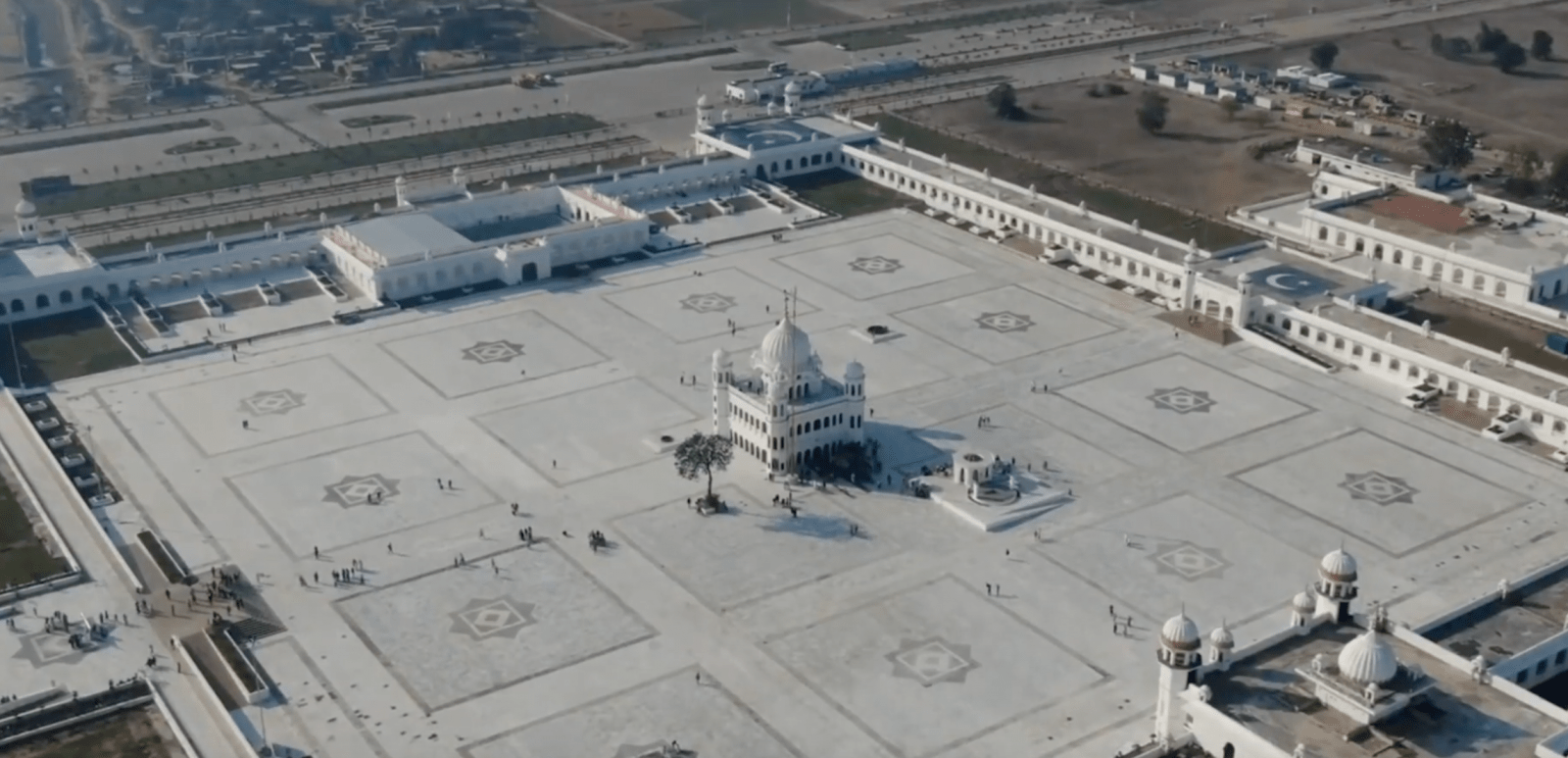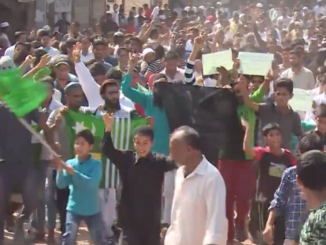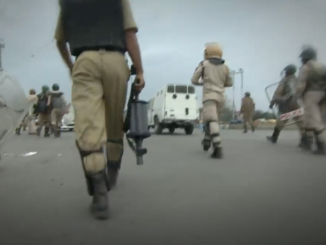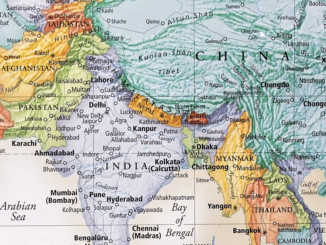 On November 9, 2019, Pakistan and India opened the first-ever visa-free corridor between the two countries to facilitate the pilgrimage of Sikhs – a minority community in both India and Pakistan but with major chunk of its populace settled in India – to their second holiest site located in Katarpur, a border village in Pakistan’s Punjab province.
On November 9, 2019, Pakistan and India opened the first-ever visa-free corridor between the two countries to facilitate the pilgrimage of Sikhs – a minority community in both India and Pakistan but with major chunk of its populace settled in India – to their second holiest site located in Katarpur, a border village in Pakistan’s Punjab province.
Inaugurated on the respective sides by the prime ministers of India and Pakistan, the 4.1 km long corridor – connecting Dera Baba Nanak Shrine in India with Gurudwara Kartarpur Sahib in Pakistan – will enable more than 5,000 devotees to visit the holy shrine every day and is widely being regarded as the first drop of rain in the decade’s long history of the desiccated and conflictual relationship between the two neighbours.
An occurrence so momentous that it effectively exalted the Prime Minister of Pakistan, Imran Khan, as the most beloved figure for Sikhs, besides actuating Prime Minister Narendra Modi to issue a rare and extraordinary message of gratitude towards his Pakistani counterpart, despite the contextual reality that later has been drawing parallels between the Indian PM and Nazi leader, Hitler, after the Indian government’s draconian venture in the disputed region of Jammu and Kashmir (J&K) steeped the relations between the two countries to an unprecedented low.
The trudge to this landmark breakthrough was as arduous and bumpy as it could have been between the two nations that share a seven-decade long history of antagonism. Although, the demand of Sikhs to be granted access to the revered shrine – located just a few kilometers away from the Radcliffe Line – is as old as the two antagonist nations, interminable strains in the relationship between the two countries proved to be an impediment in the way of this short journey across the border.
Even as Pakistan extended the olive branch and Indian politician Navjot Singh Sihdu – who attended PM Khan’s oath-taking ceremony in August last year – was apprised by Pakistani COAS about his country’s readiness to open the “corridor of peace”, cynicism and suspicion from the Indian side were axiomatic. Sidhu was barraged with denunciation back home for embracing Pakistan’s top military official, while the socialists in Indian political and strategic community tried to conjecture about the “covert designs” behind Pakistan’s apparently benevolent move. Indisputably, India was not left with any other choice except to accept the Pakistani offer as responding otherwise could have infuriated its 22 million-strong Sikh minority. Though the Modi government hesitatingly expressed its consent for the construction of the corridor, it didn’t respond positively to the successive dialogue offers made by PM Khan.
Adding to the complexity was the hyper-nationalistic and anti-Pakistan narrative adopted by PM Modi during his recent election campaign, after he had fallen short of delivering on his previous election promises regarding the transformation of the Indian economy and the improvement of people’s lives. As if Pakistan-bashing was not enough to garner votes, Modi went as far as to push the two countries almost to the brink of a nuclear exchange in February 2019, when in response to an attack – purported to be a false-flag – at Indian security forces in restive Kashmir, he ordered Indian Air Force (IAF) to bomb targets inside mainland Pakistan, provoking a daring response from Pakistan Air Force (PAF) the next day resulting in the downing of an IAF jet and the arrest of an Indian pilot by Pakistani forces, who was returned few days later.
Nevertheless, the perilous brinkmanship worked spectacularly for Modi and his right-wing BJP secured an overwhelming majority in the lower house of parliament, full credit to the shrewd manipulation of mainstream and social media – which abetted the regime’s efforts to cunningly overshadow the embarrassment of aircraft downing and capture of pilot with the celebrations of “punishing Pakistan”.
After winning elections, Modi further upped the ante in the disputed J&K and after imposing an all-out communication clampdown and enacting a security blanket over the valley of Kashmir – the state’s only Muslim majority region – unilaterally repealed the region’s decades-old semi-autonomous status.
Predictably, it evoked a strong response from Pakistan which downgraded diplomatic ties with India, cut-off trade and expelled the Indian High Commissioner while refusing to send his own to New Delhi. Then followed a long diplomatic scrimmage between the two countries with Pakistan trying to rally the support of international community against the tyrannical Indian moves in the occupied valley and India responding with countermoves aimed at hurting Pakistan diplomatically and economically, besides propagating the deceitful mantra of “all is well” for Kashmir.
Notwithstanding the reignited tensions, when Pakistan decided to move ahead with the opening of the corridor as per schedule, it was regarded as a bold diplomatic move. Though it would have earnt the country appreciation abroad, a severe backlash from the opposition at home was very much on the cards and at a time when leader of a right-wing political party Maulana Fazal-ur-Rehman was holding a sit-in in Islamabad with his thousands of zealot supporters demanding Khan’s resignation, the risk of domestic backlash had increased manifold.
Nevertheless, Khan’s government with the undisguised support of the country’s powerful military moved ahead with the decision despite criticism from opposition politicians like Maulana Fazal-ur-Rehman and Bilawal Bhutto Zardari – whose left-wing Pakistan People’s Party (PPP) frequently champions religious freedom and interfaith harmony but didn’t miss the opportune moment to ensure the “obligatory” political point-scoring.
Although, Pakistan has made a landmark move despite soaring regional tensions and domestic pressure, the opening of the border corridor can be rightfully considered as the first drop of rain after decades of desiccation; the chances that a rainstorm may follow which can convert the roads into the river, remain ever more slim and the major impediment is the simmering volcano: the dispute of Jammu & Kashmir (J&K) – a sticking point mentioned by Khan in his speech on the day of the inauguration of corridor.
For more than seven decades, the outstanding issue of J&K has been instigating hostilities between the two now nuclear-armed neighbors and recent unilateral actions by India – which violate numerous United Nations Security Council (UNSC) Resolutions and various bilateral accords with Pakistan – have just added to the fire and fury. Essentially, Modi’s regime’s recent actions in J&K have taken the matters to the point of no return and the chances of Pakistan making any further peace overtures towards India or responding to any (highly unlikely) Indian peace initiatives, are slight.
The pessimism around talks has already been echoed by Khan when he made it abundantly clear that until the Indian government ends its oppressive clampdown in the valley of Kashmir and restores pre-August 5 2019 status of disputed J&K – an even distant possibility – negotiations remains out of question.
Even though, there is a remote possibility that Khan’s government – which has almost lost its initial momentum against India over Kashmir and seems to be more concerned with other domestic and regional issues – will even subtly try to normalize the relationship with India, yet a slight nuance of any such move is likely to evoke strong backlash from the country’s religious right as well as the political opposition. And given that supporting the Kashmir cause is regarded as a symbol of nationalism in Pakistan, and the country’s powerful military establishment and Khan are already facing accusations of striking a deal on Kashmir, it is unlikely that Pakistan will venture on taking any further risk of making up with India, only to spark a general enragement.
India under Modi is undergoing a massive transformation and into the 6th consecutive year of BJP’s rule, the country’s fundamental secular outlook is under threat. In 1947, while Pakistan was being founded as a country for Muslims, India’s founding fathers envisioned a secular outlook for the culturally, religiously and ethnically diverse country. Seven decades later, the Modi regime – despite publicly pledging to safeguard India’s secular constitution – has embraced a fundamentally opposite course.
The rise of the far-right may be a global phenomenon but India presents the most extreme and violent version of this imminent menace – a reality axiomatic by the rising religious intolerance, especially against Muslims; increased and generally overlooked incidents of mob-violence against minorities; cow vigilantes – which represent a militant brand of Hindu nationalism – patrolling the streets of India to impose their own version of “law” under the state’s patronage; a sudden rise in the incidents of hate speech by the leaders of the ruling party without facing any admonishment; the taming of Indian media to ally with government’s jingoistic policies and religiously incendiary rhetoric; various democratic and constitutional institutions conceding to the majoritarian impulse rather than adhering to constitution; ever-reducing political space for dissent and opposition parties; and the recently introduced Citizenship Amendment Bill, which exclusively discriminates against Muslims.
These alarming trends clearly point out that Modi’s regime, in pursuance of Hindu supremacist Hindutva ideology – is steadfastly navigating the world’s largest democracy into the abyss of fascism. Arguably, given the emerging trends in Indian society, Khan’s analogy between Modi and Hitler was not that erroneous and many Indian politicians and commentators have also expressed concerns that the early signs of fascism are already obvious in Indian society.
Narendra Modi – who came to power with an alluring economic reform and development agenda – is now totally reliant on anti-Muslim divisive politics. The democratic and constitutional institutions of the country – which were to place a hindrance in the way of this majoritarian brand of politics seem to be accomplices. With no institutional and social hindrance to Hindutva – a brand of politics kept at bay for many decades – this divisive menace is now finally engulfing India’s political and social landscape and ultimately threatens the internal cohesion of diverse Indian society.
Given the ideological and historical context, Kashmir presented a test-case for the protagonists of Hindutva. The state of J&K – a Muslim majority region that acceded to Hindu majority India – was cherished as a symbol of India’s secular identity. However, Modi’s government’s revocation of the region’s special status – which is fundamentally aimed at paving the way for introducing massive demographic changes in the region, converting Muslims into a minority, essentially following the Israeli model in the West Bank – will not only help the regime in crushing the self-determination sentiments in the valley but will also be a major milestone achievement en route to transforming India into a Hindu state.
Ironically, Muslims living in India are not the only prey of rising Hindu fascism; and expansionist Hindutva has regional and global implications. Being a homeland to the successors of those “outsiders” who ruled the Hindu majority India for more than 850 years, Pakistan becomes the major nuisance for the Hindu supremacists currently in-charge in India. February 2019 nuclear brinkmanship by Modi regime; uninterrupted Pakistan bashing by Indian media; adaptation of a well-choreographed anti-Pakistan narrative during elections campaigns by Indian politicians; vigorous Indian attempts to get Pakistan blacklisted by FATF; and continuous fomentation of subversive activities by Indian intelligence inside Pakistan point out that Pakistan’s long-held apprehensions about India plotting to weaken the country’s federation to ultimately subsume its tumbling parts, were not misplaced.
In fact, weakening Pakistan internally, disintegrating it and ultimately subsume its parts will be a step forward in the way of realization of the “Greater India” dream of Rashtriya Swayamsevak Sangh (RSS), the organization regarded as the ideological patron of ruling BJP and the major proponent of Hindu supremacist, majoritarian and expansionist Hindutva ideology with current Indian PM and most of the leaders of BJP as its life-long members.
In a nutshell, the opening of the Kartarpur corridor may be a sanguine gesture by Pakistan but India doesn’t seem to be even interested in some reciprocity. The issue of J&K – which has become further complicated due to India’s overassertive and intransigent attitude – presents an immediate stumbling block in the way of this “first drop of rain” being followed by a “downpour”, which can turn the dry and desiccated road into a river.
In the long run, as the Modi government pursues the Hindutva policies and continues on a path to hurt Pakistan internally, economically and globally, chances of any further optimistic gesture from either side become even remote. Given the aforementioned immediate and long-term hurdles, and taking into consideration the fact that the relations between the two countries have become desiccated, the Kartarpur corridor, though noteworthy, but seems a lost opportunity that may not necessarily lead to lasting peace in the region.
![]()




Be the first to comment